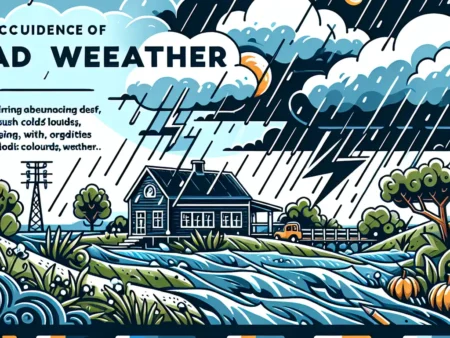Aktivitas vulkanik dapat mempengaruhi cuaca melalui pelepasan gas dan partikel ke atmosfer, yang dapat menyebabkan perubahan suhu dan pola hujan.
Bagaimana Aktivitas Vulkanik Mempengaruhi Cuaca?
-
Table of Contents
Introduction

Indonesia is a country known for its rich volcanic activity, with more than 130 active volcanoes spread across its archipelago. These volcanoes have a significant impact on the country’s weather patterns, influencing everything from temperature and rainfall to wind patterns and air quality. Understanding how volcanic activity affects the weather is crucial for predicting and mitigating the potential risks associated with volcanic eruptions. In this article, we will explore the various ways in which volcanic activity influences the weather in Indonesia.
Volcanic Eruptions and Climate Change
Volcanic Aerosols and Global Cooling
When a volcano erupts, it releases a vast amount of gases and particles into the atmosphere. One of the most significant impacts of volcanic eruptions on the climate is the release of volcanic aerosols, which are tiny particles suspended in the air. These aerosols can remain in the atmosphere for months or even years, reflecting sunlight back into space and reducing the amount of solar radiation reaching the Earth’s surface. This phenomenon leads to a temporary cooling effect on the planet, often referred to as volcanic winter.
One notable example of a volcanic eruption affecting global climate is the 1815 eruption of Mount Tambora in Indonesia. The eruption was so massive that it injected a substantial amount of aerosols into the stratosphere, resulting in a global temperature drop of about 0.4 to 0.7 degrees Celsius. The following year, 1816, became known as the “Year Without a Summer” in many parts of the world, with severe crop failures and widespread famine.
Local Weather Effects
While volcanic eruptions can have global climate impacts, they also have more immediate and localized effects on weather patterns. The release of volcanic gases, such as sulfur dioxide, can lead to the formation of volcanic clouds, which can affect the weather in the vicinity of the eruption.
Volcanic clouds can alter the temperature and humidity of the surrounding air, leading to changes in wind patterns and precipitation. In some cases, volcanic clouds can trigger the formation of thunderstorms, lightning, and even tornadoes. These weather phenomena can pose additional risks to communities living near active volcanoes.
Volcanic Ash and Air Quality
Health Hazards
Volcanic eruptions also release significant amounts of volcanic ash, which consists of tiny rock fragments and glass particles. Volcanic ash can pose severe health hazards, especially when inhaled. The fine particles can irritate the respiratory system, causing respiratory problems and exacerbating existing conditions such as asthma and bronchitis.
During volcanic eruptions, the ash can be carried by wind over long distances, affecting not only the immediate vicinity but also neighboring regions. The 2010 eruption of Mount Merapi in Indonesia, for example, resulted in the closure of airports in several countries due to the ash cloud’s potential danger to aircraft engines.
Impact on Air Quality
In addition to health hazards, volcanic ash can also have a significant impact on air quality. The fine particles can reduce visibility, leading to hazardous driving conditions and disruptions in transportation. The ash can also settle on vegetation and bodies of water, affecting ecosystems and water quality.
Volcanic ash contains various chemical compounds, including sulfur dioxide and heavy metals, which can have long-term environmental consequences. These compounds can contribute to acid rain, soil contamination, and damage to crops and livestock.
Volcanic Activity and Rainfall
Volcanic Rain
Volcanic eruptions can also influence rainfall patterns in the surrounding areas. The release of sulfur dioxide and other gases during volcanic eruptions can lead to the formation of sulfuric acid in the atmosphere. This acid can combine with water vapor to form tiny droplets, resulting in what is known as volcanic rain or acid rain.
Volcanic rain can have detrimental effects on agriculture and ecosystems. The acidic nature of the rain can damage crops, forests, and aquatic life. It can also contribute to soil erosion and leaching of nutrients, further impacting agricultural productivity.
Volcanic Ash and Rainfall
In addition to volcanic rain, volcanic ash can also affect rainfall patterns. The ash particles can act as cloud condensation nuclei, promoting the formation of clouds and precipitation. However, the presence of ash can also inhibit rainfall by interfering with the normal processes of cloud formation and precipitation.
The impact of volcanic ash on rainfall depends on various factors, including the size and composition of the ash particles, as well as the prevailing weather conditions. In some cases, volcanic ash can lead to increased rainfall, while in others, it can result in reduced rainfall or even drought conditions.
Conclusion
Volcanic activity in Indonesia has a profound influence on the country’s weather patterns. From global climate impacts to localized weather effects, volcanic eruptions can cause temporary cooling, alter wind patterns, and trigger thunderstorms. The release of volcanic ash poses health hazards and affects air quality, while volcanic rain and ash can impact rainfall patterns and agricultural productivity.
Understanding the relationship between volcanic activity and weather is crucial for disaster preparedness and mitigation efforts. By monitoring volcanic activity and studying its effects on the weather, scientists and authorities can better predict and respond to potential risks associated with volcanic eruptions.







